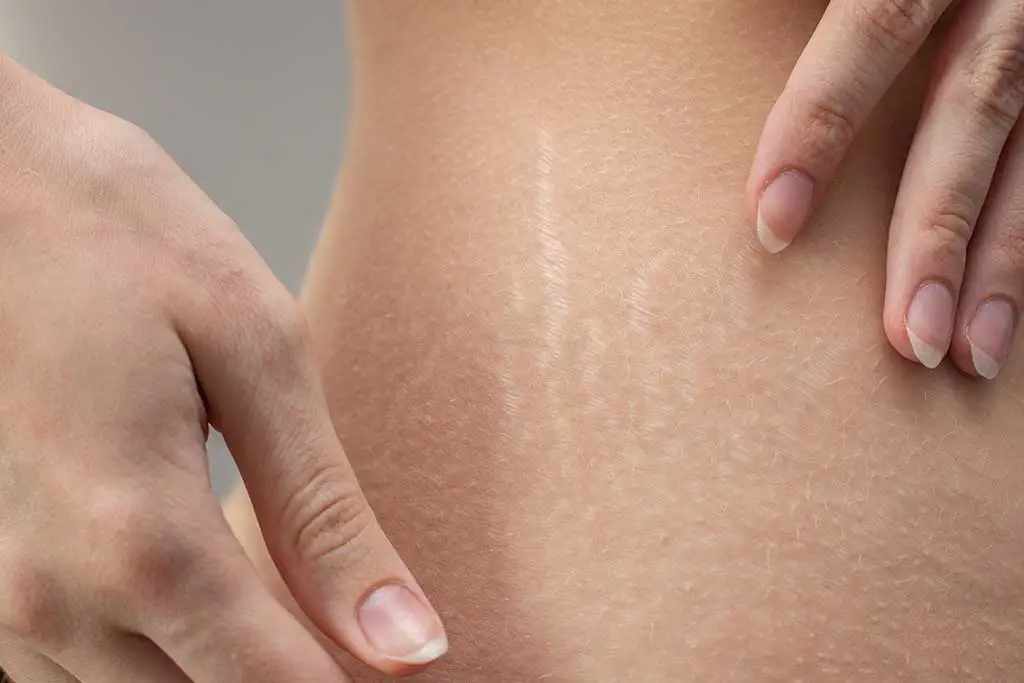How Postpartum Skin Changes and Skin Care Tips

Postpartum skin changes due to hormonal changes during pregnancy. That’s why care should start from the moment of conception and you shouldn’t wait until after giving birth.
On the other hand, in addition to the hormone changes, general fatigue, coupled with the new situation, all affect the mother’s skin. This is why your skin deserves special attention at this time.
Skin conditions associated with postpartum include stretch marks, changes in texture, flaccidity, cellulite and hyperpigmentation. The most affected is the abdominal area.
Stretch marks
Stretch marks are the main skin change in the postpartum period. They’re caused by distension due to weight gain during pregnancy and the return to normal after childbirth. This process causes collagen and elastin fibers to break down.
They’re noticeable on the abdomen, breasts, and buttocks. Once they already appear, it’s difficult to eliminate them completely. So, the recommendation is to prevent them right from the beginning.
These marks are linear and red, pink or white in color.
For stretch marks, the use of special creams combining centella asiatica and hyaluronic acid is recommended. Similarly, part of postpartum skin care involves the use of moisturizers. These should contain rosehip and vitamin K, which stimulate collagen production.
Although stretch marks don’t disappear, they can be reduced. In addition, if they have appeared recently, they can be improved with aesthetic laser and radiofrequency treatments.
Care from within, keeping hydrated with plenty of water, and the consumption of foods that stimulate the synthesis of collagen, are also beneficial.

Read more: DIY Stretch Mark Cream with Vitamin E
Postpartum skin flaccidity
Especially in the skin in the abdomen area, some flaccidity occurs due to distension and subsequent rearrangement. It’s recommended to use moisturizing and firming creams for this.
The latter help to restore firmness and elasticity and contain compounds such as sweet almond, avocado, rosehip, centella asiatica, shea oil, vitamin E and jojoba.
Cellulite
Also known as orange peel, it’s produced by the accumulation of fatty tissue that forms lumps and holes in the dermis. It’s mainly noticed in the buttocks, thighs, and hips.
It’s related to family predisposition, sudden weight gain, stress, sedentary life, consuming abundant carbohydrates, and fluid retention. That’s why the most important thing is to exercise regularly and eat a balanced diet.
Lymphatic drainage and massage therapy can be used as a treatment. This helps to activate circulation and improve water retention. So-called anti-cellulite creams can help with texture and color, but don’t resolve the lumps.
Postpartum facial skin texture changes
Two issues are most noticeable at this point:
- Dry, flaky skin: The sharp drop in progesterone and estrogen levels postpartum causes the skin to become more sensitive and dry. Moisturizing creams with hyaluronic acid and a gentle facial cleanser are recommended.
- Acne: Due to the sudden drop in estrogen level, the sebaceous glands are activated and produce more oil. Acne may also be favored by stress caused by the arrival of your baby. Creams with azelaic acid or benzoyl peroxide are recommended.
Dark circles under the eyes
Tiredness, stress, and long sleepless nights result in bags and hyperpigmentation in the eyelids. Although the most advisable thing to do is to rest, when this isn’t possible, other tips can be followed, such as the use of caffeine-based creams, gels, or serums, as well as creams that include vitamin C.
Read more: Do You Have Dark Circles Under Your Eyes? Hide Them Naturally!
Hyperpigmentation of the skin in the postpartum period
Due to hormonal changes, hyperpigmentation of the skin occurs due to excess melanin. In the second and third trimesters of gestation, the melanocyte-stimulating hormone reaches its highest levels, a product of increased progesterone and estrogens.
Excess melanin (a substance produced by melanocytes in the outermost layer of the skin), in conjunction with exposure to sunlight, leads to hyperpigmentation. The most characteristic result is a brownish spot on the cheeks, upper lip, forehead, and nose. This is called chloasma gravidarum or melasma.
Freckles, marks and scars that existed on the skin before pregnancy may also darken.
Melasma doesn’t disappear until 3 to 6 months after delivery, when hormones return to normal. The same happens with hyperpigmentation of the areolas of the nipples and the linea alba of the abdomen.
The use of depigmentation creams or any type of aesthetic treatment isn’t recommended until 6 months after childbirth. It’s best to consult a dermatologist.
It’s best to prevent it by using physical (hat, sunglasses, umbrella) or chemical (sunscreen) barriers, especially in the summer.

Spider veins
One of the changes that occurs in the skin in the postpartum period is the appearance of spider veins. They occur because there’s an increase in blood flow, which dilates the vessels.
They look like small, bright red spots, surrounded by blood vessels that resemble spider legs. They usually disappear gradually by the seventh month.
Postpartum skin care recommendations
Taking time to enjoy and care for yourself is key. Ask for relief from baby care, shower without watching the clock, and dedicate yourself to a skincare routine.
Skin should be deeply moisturized. Use creams all over the body, not forgetting the areola and nipple area. You can exfoliate once a week.
Besides that, try to stay active. Do at least 30 minutes of physical exercise, 5 times a week.
Eat a healthy, balanced diet, rich in collagen-stimulating foods. Also include products with vitamin A and E, such as the following:
- Dairy products
- Citrus fruits
- Kiwi fruit
- Nuts
- Vegetable oils
- Green leafy vegetables
The process may take a while, because the elasticity and firmness must return to normal after stretching almost 10 times its size. It can take up to 6 months for the abdomen to return to its normal state; that’s how long it takes for the uterus to fully contract.
Postpartum skin care depends on lifestyle habits. Focus on your baby, but don’t neglect yourself either.
All cited sources were thoroughly reviewed by our team to ensure their quality, reliability, currency, and validity. The bibliography of this article was considered reliable and of academic or scientific accuracy.
- Artal R. Cambios físicos durante el embarazo. Manual MSD Versión para público general. Disponible en https://www.msdmanuals.com/es-ve/hogar/salud-femenina/embarazo-normal/cambios-f%C3%ADsicos-durante-el-embarazo.
- Font E. Cuidado de la piel en el embarazo y en el postparto. Offar 2003;22(2). Disponible en https://www.elsevier.es/es-revista-offarm-4-pdf-13043198.
- Estrella V, Barraza S, Sánchez A, Fernández Bussy R A. Piel y embarazo. Rev. argent. dermatol. [Internet]. 2006; 87(4):264-277. Disponible en: http://www.scielo.org.ar/scielo.php?script=sci_arttext&pid=S1851-300X2006000300004&lng=es.
This text is provided for informational purposes only and does not replace consultation with a professional. If in doubt, consult your specialist.









